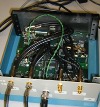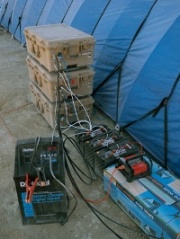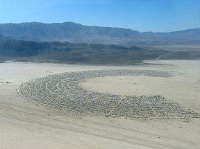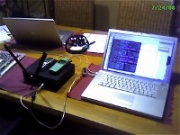Free networks
(→mesh networks) |
(→amateur radio) |
||
| Line 29: | Line 29: | ||
* [http://en.wikipedia.org/wiki/AMPRNet AMPRNet wikipedia article] | * [http://en.wikipedia.org/wiki/AMPRNet AMPRNet wikipedia article] | ||
* [https://www.noisebridge.net/wiki/HInternet Hinternet proposed by Noisebridge San Fransisco] | * [https://www.noisebridge.net/wiki/HInternet Hinternet proposed by Noisebridge San Fransisco] | ||
| − | * [http://en.wikipedia.org/wiki/High_Speed_Multimedia HSMM wikipedia article] | + | * [http://en.wikipedia.org/wiki/High_Speed_Multimedia High speed multimedia (HSMM) wikipedia article] |
| + | * [http://www.qsl.net/n9zia Green bay professional packet radio qsl.net/n9zia] has lots of interesting information | ||
===mesh networks=== | ===mesh networks=== | ||
Revision as of 23:28, 6 December 2012
see also free networks zine with images, français and english
If you choose not to rely on electronic communication, thats great. But for those of us who do, isn't it time we set up community run alternatives?
People are spending a lot of money on commercially provided communication, sometimes more than they do on food. and they're getting more and more obsessed with it. we all are! just look around you!
it is also a major tool of control and regulation by government and industry. the more we rely on it the more we submit ourselves to them.
Community run alternatives could be secure, free from advertising and censorship, powered off-grid, free and accessible. this would provide a serious threat to the infrastructure used to control us. this might seem like a long way off, but things can change fast - good ideas can snowball...
In feburary 2012 the non-profit website 'scroogle' which offered an alternative version of google (where searches were not recorded) was taken down after action against it taken by google. Then in march 2012 google put into practice their new privacy policy, making users search history available to other google owned sites. Of course other sites exist which provide secure web searches.
US develops internet kill switch [1] Egyptian government switches off internet during uprising
In order for a community run network to become popular, we need some standards, and a way for different networks to link together. A small group might use high frequencies to get high bandwidth communication locally, but how can we connect that communication with lower frequency, longer range links to other communities. If we are going to set up some sort of repeaters or base stations to link groups, they need to be useful to everyone, and not dependent on other parts of the network. Some repeaters might be installed in vehicles or boats that move around. Or they might be dependent or wind or sun for power – so they cannot be always relied upon.
Contents |
amateur radio
Community run 'amateur' radio communication has existed for over a hundred years. It is both a local and an international network and has often been relied upon when other communications have broken down because of disasters such as floods. Data modulation systems such as psk31 can allow transmission of text or digital images, which can operate over thousands of miles on HF.
Using the amateur bands requires a lisence and an official 'callsign', which are relatively cheap and easy to get, but there are restrictions which may cause a problem if we want to create a secure, free and independent community run network. For example sending encrypted messages is forbidden, and lisences are obtained from a centralised association, which stores personal details of its users and is likely to cooperate with other authorities. Of course we could use similar systems illegally, but as an existing network it has the advantage of having estabilished and well documented international standards, as well as infrastructure such as repeater stations.
TCP/IP (internet protocol) can also be used over amateur packet radio and is not a new idea. In fact amateur radio networks were using internet protocol even before the internet became a public service. Amateur radio users have been allocated a substantial portion of the IPv4 Internet address space - IP addresses 44.0.0.0/8, thats 16 million IP addresses.
- AMPRNet wikipedia article
- Hinternet proposed by Noisebridge San Fransisco
- High speed multimedia (HSMM) wikipedia article
- Green bay professional packet radio qsl.net/n9zia has lots of interesting information
mesh networks
Recently the idea of creating mesh networks using 802.11 'wifi' on 2.4GHz has become popular, with many projects already established, mainly in cities. The advantage is that the equipment is already widely available and only firmware changes need to be made.
- Freifunk
- English wikipedia article on Freifunk
- Community wireless.org
- mesh networks research group
- Wireless community netowork
- Netsukuku mesh network system software project
- Consume.net
- OpenWRT Open source customisable firmware for wireless routers
The problem is the range limitations make it impractical anywhere other than extremely densely populated cities. It would be nice to have something more robust which could give access to those in the countryside, as well as on vehicles and boats.
One solution is to stick with 2.4GHz but use amplifiers and good antennas. The amplifiers are expensive.
Another idea is to use lower frequencies but with a very similar protocol which could easily be linked to existing systems. It is possible to use the same system but on 400Mhz - just removing the 2GHz from the signal. A couple of wireless cards are able to do this - the Doodle labs DL435-30 and Xargl communications something. Interestingly there is an amateur form 400Mhz, meaning amateurs can legally use this frequency.
The problem is bandwidth - 2.4GHz wifi uses about 10MHz bandwidth - but can be configured to 5Mhz. The nice thing is that the software does not need much changing - the computer 'sees' the wireless card as a normal 2.4GHz device.
Wireless Regional area networks
A standard for WRAN (wireless regional area networks), IEEE 802.22 has recently been developed, which will use 'white spaces' in the VHF and UHF bands, previously used by analogue TV broadcasting. The standard is likely to be used by commercial internet service providers to cover rural areas - internet base stations could operate over a 60km radius, like TV transmitters. It is the first international standard to use 'cognitive radio' to eliminate interference with existing TV signals. This makes it likely that transmission equipment will be software defined.
- IEEE 802.22 WRAN wikipedia article
- ieee802.org/22 official IEEE site
- ieee802.22 WRAN standard article on radio-electronics.com
software defined radio
Software Defined Radio devices, such as the Universal Software Radio Peripheral (USRP), produced in the US by « Ettus research », could be very useful in establishing a community run network. They are computer controlled radios, where various aspects of the radio's operation which traditionally were done by analogue hardware devices, in paticular the modulation and demodulation of the RF signal, are done digitally by software. This has only recently become posibile because with radio frequency high sampling rates are required and computers need to run fast enough to demodulate them. The advantage is that software defined radio devices are flexible, adaptable and easy to modify. For example by changing the software that the USRP is running, it could act as a FM transmitter, GPS reciever, digital TV decoder, VHF tranciever, whatever... Of course some hardware changes (such as antennas and the USRPs 'daughter board' circuits) are required, but essentially it is software which defines the USRPs operation. There are many commerically available software defined radio devices, but the USRPs is particularly interesting because its circuit design is published openly and the software it runs, GNUradio, is open source.
- USRP - universal serial radio peripheral for use with GNUradio
- wired.com article on the USRP
- wikipedia article on software-defined radio
- wirelessinnovation.org has stuff about software defined radios (but seems positive about military/commercial applications)
- tools4sdr.com wiki about software defined radio. has stuff about USRP and WRAN standard.
- OpenHPSDR.org High performance SDR, an open source design
Making devices more flexible by increasing the extent to which they are controlled by software is good because when the device is no longer needed if can be used for something else instead of being thrown away. The arduino, a multi-perpose programmable device, is a good example of this. Software defined radio is likely to gain popularity in the coming years, which is interesting because it is easy to modify for different perposes. So we could modify commercial devices to work with our own set of standards – and if we change those standards at some point we will not need to get new equipment.
The USRP has been used in projects to decode GSM mobile phone signals as well as high definition TV signals. It is also used in a project to create easy to build GSM base stations, (OpenBTS) which can be battery powered. A free mobile network using the USRP running OpenBTS (with some RF amplifiers) and powered by wind has been set up at Burning man festival for several years (But they got an official lisence). Of course if an unlisenced GSM network was to get popular, we would be likely to have problems with the authorities very quickly. But the advantage is that individual users need only a mobile phone – and thousands of them are being thrown away.
- OpenBTS
- Exploring GNU radio article
- The OpenBTS Chronicles OpenBTS at Burning man 08
- Rowetel blog about free telephony, developing world telephony, open hardware, renewables
- GSM Scanner Project - seems to have gone down - why?
- GSM researcher stopped at heathrow airport by UK government officials
There seems to be a number of reasons why Software defined radio could be useful for community run communication systems. It could allow us to create something genuinely independent of existing commerically provided systems, whilst being able to re-use redundant hardware from these systems. Changes can be made to the standards of how the system works without requiring any new hardware – saving resources. Frequencies can be dynamically allocated, allowing different types of hardware to work together and interference with other systems to be avoided automatically. Software is easier to work on collectively than hardware.
Decentralised community run systems will encourage people locally to interact, as information spreads geographically. If you are searching for something or announcing that you have something to offer, it will be naturally easier to find responses nearby. Compared to the internet, it will be more chaotic, but in a beautiful self-organising way. Text/images/music/whatever will spread geographically and and be able to discover the same stuff as others nearby but it will change all the time as ideas/art spread between groups like a roumour. Like they have a life of their own.
free/community communication projects/sites
- freeswitch software telephone platform
- [2]
- british amateur radio teledata group




